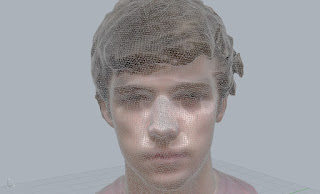In order to get a 3D version of my head into Rhino, I had to sit in a chair for 30 second white someone walked a perfect circle around me. Frankie, my Professor was holding a 3D scanner plugged into a laptop. Multiple scans were done were done with different angles in order to get all features of the face. Once I imported the file into rhino I have an editable mesh of my own head..
The idea for this project started out with sketches of archways based on art deco style. once I had the basic sketch laid out I used it as a reference to recreate the same design in Rhino using arcs. Once the line work is completed and connected, the design is copy and pasted into a seamless flat design.In order to ensure the ring fits the design is scaled onto a line that is the same length as the circumference as the sized finger. Once as the design has been oriented around the correct size ring into a cylinder a few simple commands are used complete the ring. I used the pipe command to make consistent tubing to create the solid structure of the ring. The final command used was Boolean Union which took the individual pieces of pipe and joined all of them together with no overlapping solids. The Final product is amazing, I am pleased with quality and detail of the finished product. The satisfaction is immense considering I started with...





Comments
Post a Comment